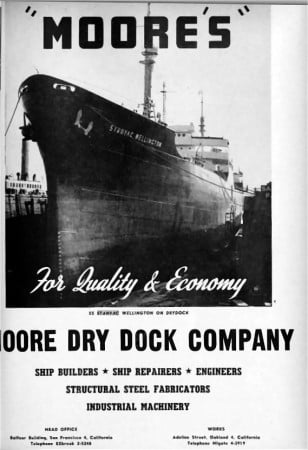Moore Dry Dock (Moore Shipbuilding) played an integral part in repairing and building ships during World War II. However, the company’s use of amianto injured thousands of workers constantly exposed to the dangerous material. Some later developed mesotelioma or other asbestos illnesses.
If you or a loved one suffer from mesothelioma, asbestos-related lung cancer, or asbestosis, you may qualify for substantial compensation. Currently, there is over $30 billion in asbestos trust funds, awaiting those who’ve been diagnosed with an asbestos illness. Llene nuestro formulario para recibir nuestro boletín gratuito Financial Compensation Packet. Our packet is loaded with information on experienced mesothelioma attorneys in your area, how to file a claim for asbestos trust funds, how to get paid in 90 days, and more.


Paquete de compensación financiera GRATUITO
- Información sobre despachos de abogados que recuperarán su INDEMNIZACIÓN MÁS ALTA
- Aprenda cómo cobrar en 90 días
- Solicite su parte de $30 mil millones en fondos fiduciarios

Did Moore Dry Dock Use Asbestos?
Until its closure in 1961, Moore Dry Dock used asbestos in its operations. Like many other shipyards, Moore Dry Dock used asbestos in shipbuilding and repair.
Asbestos was commonly used in the shipbuilding industry because of its insulating properties and ability to provide fireproofing. Most shipyards used asbestos until greater awareness of its health risks spread, and the government began regulating it in the 1970s.
Moore Dry Dock History
Moore Dry Dock was founded in 1905 and was originally located in San Francisco. It began when the founders purchased National Iron Works and named the new business Moore & Scott Iron Works.
The company changed its name to Moore Shipbuilding shortly before the start of World War I. At the same time, the business moved to Oakland. It focused primarily on ship repair. The name then changed to Moore Dry Dock Company in 1922.
Before World War I, Moore Dry Dock repaired commercial vessels like dredgers, ferries, and tankers. During the war, the company swelled to more than 12,000 employees and contributed to the war effort. It provided more than 60 new ships.
After World War I, Moore Dry Dock returned to the ship repair business, and the number of employees dropped significantly.
When World War II started, the company began shipbuilding again. It received a Marina de los EE. UU. contract to build ships. This was the peak period of activity at Moore Dry Dock, with more than 35,000 workers. They made 112 ships for the Navy before and during WWII.
The company focused on ship repair over the years following the war. Moore Dry Dock closed its doors permanently in 1961. Schnitzer Steel Industries, Inc. bought the site in Oakland.
How Did Moore Dry Dock Use Asbestos?
Most shipyards that operated during the same time as Moore used asbestos. Asbestos use in shipbuilding and repair peaked from the 1930s to the 1970s.
Asbestos was found in hundreds of components that went into all kinds of vessels:
- Aislamiento
- Pipes
- Zapatillas
- Cemento
- Calderas
- Juntas
- válvulas
- Adhesivos
- Textiles
Shipyards also used asbestos in fire protective gear, such as that worn by welders. It was found in the insulation in buildings on-site and in friction parts in machinery and vehicles.
Asbestos Exposure at Moore Dry Dock
The shipyard’s asbestos use exposed many workers at Moore Dry Dock to asbestos. Anyone who worked there was at risk of exposure because asbestos materials shed fibers into the air.
Although the military understood the dangers of asbestos, it didn’t inform shipyard workers nationwide. Numerous workers in various job functions at Moore Dry Dock were at high risk of exposure to asbestos, including:
- Instaladores de aislamiento
- Instaladores de tuberías
- electricistas
- Soldadores
- Boilermakers
- Repair workers
- Pintores
- Sanders
Exposición al amianto de segunda mano
In addition to workers expuesto al amianto at Moore Dry Dock, many family members who never set foot on the shipyard were also exposed to the toxic minerals.
Workers generally did not wear protective gear and rarely changed clothes before leaving work. Many left work with clothing covered asbestos fibers that permeated throughout their homes.
Asbestos Lawsuits Against Moore Dry Dock Company
In the past, shipyards were typically not held liable for asbestos exposure. Instead, the manufacturers that shipped asbestos-containing products to the shipyards were targeted in thousands of asbestos-related and demandas por mesotelioma.
One case that involved Moore Dry Dock illustrated the direct risks to workers and the risk of secondhand exposure in families.
Sandra Foglia filed a lawsuit in 2018 after her son was diagnosticado con mesotelioma. He was exposed to asbestos fibers from his father, who worked at Moore Dry Dock. Unfortunately, she did not win their case. The court decided in favor of Moore, which stated it had no duty of care for the family of an employee.
Many other cases brought by asbestos exposure victims have been successful, providing them and their families with much-needed compensation.
Seeking Compensation for Asbestos Exposure at Moore Dry Dock
Victims of asbestos exposure at Moore Dry Dock and other shipyards have a couple of options for seeking compensation after being diagnosed with an asbestos illness:
- Mesothelioma or asbestos lawsuit. Asbestos illnesses are generally considered personal injuries, so you can file a lawsuit to seek damages. Most of these lawsuits are filed against asbestos companies that supplied shipyards like Moore.
- Reclamación al fondo fiduciario del amianto. If the asbestos companies that exposed you have gone bankrupt, you cannot sue. They should have set up an asbestos trust fund to compensate victims like you. You could be eligible for one or more of these trusts.
If you have mesothelioma after working at Moore Dry Dock or another shipyard, contact an asbestos attorney or law firm for advice and guidance.
Additional Help and Resources for Asbestos Victims
If you’ve been injured by mesothelioma, asbestos-related lung cancer, or asbestosis, keep in mind that there is a good chance that you’ll qualify for considerable compensation. Remember to fill out our form to get your free Financial Compensation Packet, with information on asbestos and mesothelioma lawyers. If you have questions or need additional assistance, contact us at 800-793-4540.

Pablo Danziger
Revisor y editorPaul Danziger creció en Houston, Texas, y se licenció en Derecho en la Facultad de Derecho de la Universidad Northwestern en Chicago. Durante más de 25 años, se ha dedicado a representar a víctimas de mesotelioma y a otras personas afectadas por la exposición al asbesto. Paul y su bufete han representado a miles de personas diagnosticadas con mesotelioma, asbestosis y cáncer de pulmón, obteniendo indemnizaciones significativas para los clientes lesionados. Cada cliente es fundamental para Paul y atenderá todas las llamadas de quienes deseen hablar con él. Paul y su bufete se encargan de casos de mesotelioma en todo Estados Unidos.
Conéctese con el abogado especializado en mesotelioma Paul Danziger
Referencias
- The Moore Shipbuilding Company. (1920, July). Pacific Marine Review.
Recuperado de: http://books.google.com/books?id=oq0-AQAAIAAJ&pg=PA59&lpg=PA59#v=onepage&q&f=false - Hedley-Whyte, J. y Milamed, DR (septiembre de 2008). Amianto y construcción naval: consecuencias fatales. Ulster Med. J. 77(3), 191-200.
Recuperado de: https://www.ncbi.nlm.nih.gov/pmc/articles/PMC2604477/ - Court of Appeal of the State of California, First Appellate District, Division Two. (2018, March 8). Foglia v. Moore Dry Dock Co.
Recuperado de: https://casetext.com/case/foglia-v-moore-dry-dock-co
